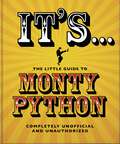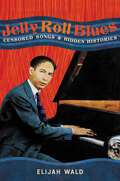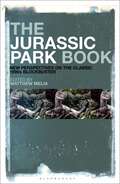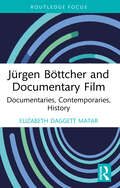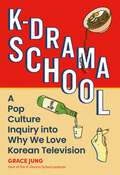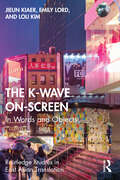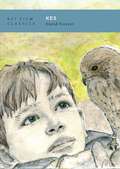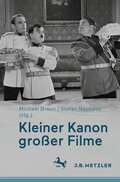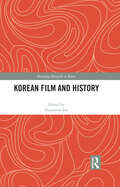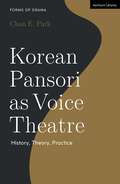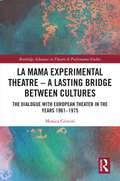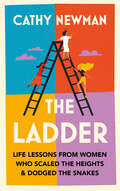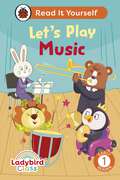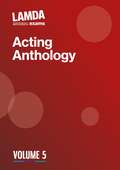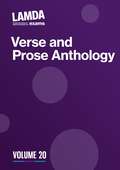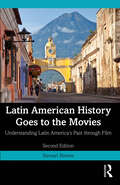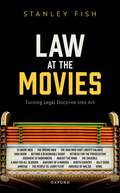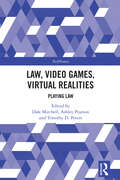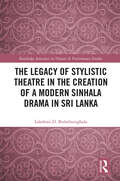- Table View
- List View
It's... The Little Guide to Monty Python: ... And Now For Something Completely Different (The\little Book Of... Ser.)
by Orange Hippo!Made from the paper of the mightiest tree in a forest and cut to size with a herring, this Little Guide to Monty Python may be only-ever-so slightly bigger than one of Mr Creosote's wafer-sized mints, but it's packed with enough preposterous comedy power to keep Pythonites stuffed with laughter until breakfast.Monty Python, of course, do not require an introduction. Python are the UK's original legends of comedy; as influential as they are innovative, as incomparable as they are intelligent. For sixty years, their unique brand of ensemble silliness has travelled the world as much as Michael Palin's toothbrush, their legacy growing with each generation.This tiny time can barely contain the 185 or so classic quotes, one liners, character flaws and jokes that made the troupe so famous, all revealed in the profoundly preposterous wit, wisdom and words of the Pythons themselves.All together now... "Always look on the bright side of life..."'I always wanted to be an explorer, but it seemed I was doomed to be nothing more than a very silly person.' Michael Palin
Jelly Roll Blues: Censored Songs and Hidden Histories
by Elijah WaldA bestselling music historian follows Jelly Roll Morton on a journey through the hidden worlds and forbidden songs of early blues and jazz. In Jelly Roll Blues: Censored Songs and Hidden Histories, Elijah Wald takes readers on a journey into the hidden and censored world of early blues and jazz, guided by the legendary New Orleans pianist Jelly Roll Morton. Morton became nationally famous as a composer and bandleader in the 1920s, but got his start twenty years earlier, entertaining customers in the city&’s famous bordellos and singing rough blues in Gulf Coast honky-tonks. He recorded an oral history of that time in 1938, but the most distinctive songs were hidden away for over fifty years, because the language and themes were as wild and raunchy as anything in gangsta rap. Those songs inspired Wald to explore how much other history had been locked away and censored, and this book is the result of that quest. Full of previously unpublished lyrics and stories, it paints a new and surprising picture of the dawn of American popular music, when jazz and blues were still the private, after-hours music of the Black "sporting world." It gives new insight into familiar figures like Buddy Bolden and Louis Armstrong, and introduces forgotten characters like Ready Money, the New Orleans sex worker and pickpocket who ended up owning one of the largest Black hotels on the West Coast. Revelatory and fascinating, these songs and stories provide an alternate view of Black culture at the turn of the twentieth century, when a new generation was shaping lives their parents could not have imagined and art that transformed popular culture around the world—the birth of a joyous, angry, desperate, loving, and ferociously funny tradition that resurfaced in hip-hop and continues to inspire young artists in a new millennium.
The Jurassic Park Book: New Perspectives on the Classic 1990s Blockbuster
by Matthew MeliaThe definitive 1990s blockbuster, Steven Spielberg's Jurassic Park met with almost universal critical and popular acclaim, broke new ground with its CGI recreation of dinosaurs, and started one of the most profitable of all movie franchises. To mark the film's 30th anniversary, this exciting illustrated collection of new essays interrogates the Jurassic Park phenomenon from a diverse range of critical, historical, and theoretical angles. The primary focus is on Jurassic Park itself but there is also discussion of the franchise and its numerous spin-offs.As well as leading international scholars of film studies and history, contributors include experts in special effects, science on screen, fan studies, and palaeontology. Comprehensive, up to date, and accessible, The Jurassic Park Book appeals not only to students and scholars of Hollywood and contemporary culture, but also to the global audience of fans of the greatest of all dinosaur movies.
Jürgen Böttcher and Documentary Film: Documentaries, Contemporaries, History (Routledge Focus on Film Studies)
by Elizabeth Daggett MatarJürgen Böttcher and Documentary Film introduces the reader to this east-German filmmaker who, despite having made 40 films from the east side of the Berlin Wall, is practically unknown. Through the comparison of films made in the same year, one by an American and one by Böttcher, the author places him as ahead of his time in regards to technology, content, and style, and neck-and-neck with contemporary American filmmakers in cinéma vérité/direct cinema. The book moves beyond Böttcher’s dramatic biography to explore his role in the history of film. Was it actually the Germans who created sync sound for documentary? When and how were women featured? Offering a concise journey through the history of documentary film within this cultural context, but also a deep-dive into specific case-studies that show the nuances and complexities of classifying film texts, this volume will interest students and scholars of film studies, German cinema, cinéma vérité, film production, film theory, and world cinema.
Jürgen Böttcher and Documentary Film: Documentaries, Contemporaries, History (Routledge Focus on Film Studies)
by Elizabeth Daggett MatarJürgen Böttcher and Documentary Film introduces the reader to this east-German filmmaker who, despite having made 40 films from the east side of the Berlin Wall, is practically unknown. Through the comparison of films made in the same year, one by an American and one by Böttcher, the author places him as ahead of his time in regards to technology, content, and style, and neck-and-neck with contemporary American filmmakers in cinéma vérité/direct cinema. The book moves beyond Böttcher’s dramatic biography to explore his role in the history of film. Was it actually the Germans who created sync sound for documentary? When and how were women featured? Offering a concise journey through the history of documentary film within this cultural context, but also a deep-dive into specific case-studies that show the nuances and complexities of classifying film texts, this volume will interest students and scholars of film studies, German cinema, cinéma vérité, film production, film theory, and world cinema.
K-Drama School: A Pop Culture Inquiry into Why We Love Korean Television
by Grace JungFrom the Emmy Award-winning Squid Game to streaming sensations like The Glory and Crash Landing on You, Korean television has emerged onto the global pop culture scene as compelling television—but what exactly makes these shows so irresistibly bingeable? And what can we learn about our societies and ourselves from watching them? From stand-up comedian and media studies PhD Grace Jung comes a rollicking deep dive into the cultural significance of Korean television. K-Drama School analyzes everything from common tropes like amnesia and slapping to conspicuous product placements of Subway sandwiches and coffee; to representations of disability, race and gender; to what Korea's war-torn history says about South Korea&’s media output and the stories being told on screen. With chapters organized by "lessons," each one inquiring into a different theme of Korean television, K-Drama School offers a groundbreaking exploration into this singular form of entertainment, from an author who writes with humor and heart about shows that spur tears and laughter, keeping us glued to the TV while making fans of us all. Shows discussed include: Squid Game, SKY Castle, Crash Course in Romance, Extraordinary Attorney Woo, My Mister, Something in the Rain, One Spring Night, DP, Guardian: The Lonely and Great God, Autumn in My Heart, Winter Sonata, Our Blues, and more.
The K-Wave On-Screen: In Words and Objects (Routledge Studies in East Asian Translation)
by Jieun Kiaer Emily Lord Loli KimThe K-Wave On-Screen provides an engaging and accessible exploration of the meaning of ‘K-’ through the lens of words and objects in K-dramas and K-films. Once a small subculture known only to South Korea’s East Asian neighbours, the Korean Wave has exploded in popularity around the globe in the last decade. Its success has been fuelled by social media and the advanced technological capabilities of South Korea. With #KpopTwitter having amassed 7.8 billion tweets and with K-films receiving acclaim from major award ceremonies, the K-wave is now a global cultural phenomenon. This book touches on globally popular productions, such as Parasite (2019), Squid Game (2021), Pachinko (2022), SKY Castle (2018), and Kim Ji-young: Born 1982 (2019) to highlight that K- has departed from the traditional meaning of ‘Korean-ness’ to become a new, globally-informed, and hybrid entity. This book will be of interest to students in East Asian studies, and those engaged with Korean language learning. The book will also appeal to those interested in Korean culture and media.
The K-Wave On-Screen: In Words and Objects (Routledge Studies in East Asian Translation)
by Jieun Kiaer Emily Lord Loli KimThe K-Wave On-Screen provides an engaging and accessible exploration of the meaning of ‘K-’ through the lens of words and objects in K-dramas and K-films. Once a small subculture known only to South Korea’s East Asian neighbours, the Korean Wave has exploded in popularity around the globe in the last decade. Its success has been fuelled by social media and the advanced technological capabilities of South Korea. With #KpopTwitter having amassed 7.8 billion tweets and with K-films receiving acclaim from major award ceremonies, the K-wave is now a global cultural phenomenon. This book touches on globally popular productions, such as Parasite (2019), Squid Game (2021), Pachinko (2022), SKY Castle (2018), and Kim Ji-young: Born 1982 (2019) to highlight that K- has departed from the traditional meaning of ‘Korean-ness’ to become a new, globally-informed, and hybrid entity. This book will be of interest to students in East Asian studies, and those engaged with Korean language learning. The book will also appeal to those interested in Korean culture and media.
Kes (BFI Film Classics)
by David ForrestKen Loach's 1969 drama Kes, considered one of the finest examples of British social realism, tells the story of Billy, a working class boy who finds escape and meaning when he takes a fledgling kestrel from its nest.David Forrest's study of the film examines the genesis of the original novel, Barry Hines' A Kestrel for a Knave (1968), the eventual collaboration that brought it to the screen, and the film's funding and production processes. He provides an in depth analysis of key scenes and draws on archival sources to shed new light on the film's most celebrated moments. He goes on to consider the film's lasting legacy, having influenced films like Ratcatcher (1999) and This is England (2006), both in terms of its contribution to film history and as a document of political and cultural value. He makes a case for the film's renewed relevance in our present era of systemic economic (and regional) inequality, alienated labour, increasingly narrow educational systems, toxic masculinity, and ecological crisis. Kes endures, he argues, because it points towards the possibility for emancipation and fulfilment through a more responsive and nurturing approach to education, a more delicate and symbiotic relationship with landscape and the non-human, and an emotional articulacy and sensitivity shorn of the rigid expectations of gender.
Kleiner Kanon großer Filme
by Michael Braun Stefan NeuhausWas macht einen Film groß? Für Truffaut war es niemals das ‚Runde‘ oder ‚Perfekte‘, Peter Hamm ergänzte, dass das Vergnügen des Kritikers oft da anfange, wo das der anderen aufhöre, bei Stilbrüchen etwa oder Exzessen. Was sind überhaupt Gründe dafür, bestimmte Filme besonders sehenswert zu finden? Die von Literatur-, Film- und Kulturwissenschaftler:innen geschriebenen Beiträge dieses Bands präsentieren je einen Film und begründen ausführlich, weshalb gerade er zu den größten der Geschichte gehört. Die Auswahl ist weder exklusiv noch elitär, sie regt zum Nachdenken an, weshalb uns auch Filme jenseits des Blockbuster-Kinos und der gängigen Kanonlisten in den Bann schlagen. Inmitten bekannter Klassiker von Lang, Chaplin, Hitchcock & Co. und jüngerer Meisterwerke von Haneke, Almodóvar und Sofia Coppola gibt es manchen Geheimtipp zu entdecken.
Korean Film and History (Routledge Research on Korea)
by Hyunseon LeeCinema has become a battleground upon which history is made – a major mass medium of the twentieth century dealing with history. The re-enactments of historical events in film straddle reality and fantasy, documentary and fiction, representation and performance, entertainment and education. This interdisciplinary book examines the relationship between film and history and the links between historical research and filmic (re-)presentations of history with special reference to South Korean cinema. As with all national film industries, Korean cinema functions as a medium of inventing national history, identity, and also establishing their legitimacy – both in forgetting the past and remembering history. Korean films also play a part in forging cultural collective memory. Korea as a colonized and divided nation clearly adopted different approaches to the filmic depiction of history compared to colonial powers such as Western or Japanese cinema. The Colonial Period (1910-45) and Korean War (1950-53) draw particular attention as they have been major topics shaping the narrative of nation in North and South Korean films. Exploring the changing modes, impacts and functions of screen images dealing with history in Korean cinema, this book will be of huge interest to students and scholars of Korean history, film, media and cultural studies.
Korean Film and History (Routledge Research on Korea)
Cinema has become a battleground upon which history is made – a major mass medium of the twentieth century dealing with history. The re-enactments of historical events in film straddle reality and fantasy, documentary and fiction, representation and performance, entertainment and education. This interdisciplinary book examines the relationship between film and history and the links between historical research and filmic (re-)presentations of history with special reference to South Korean cinema. As with all national film industries, Korean cinema functions as a medium of inventing national history, identity, and also establishing their legitimacy – both in forgetting the past and remembering history. Korean films also play a part in forging cultural collective memory. Korea as a colonized and divided nation clearly adopted different approaches to the filmic depiction of history compared to colonial powers such as Western or Japanese cinema. The Colonial Period (1910-45) and Korean War (1950-53) draw particular attention as they have been major topics shaping the narrative of nation in North and South Korean films. Exploring the changing modes, impacts and functions of screen images dealing with history in Korean cinema, this book will be of huge interest to students and scholars of Korean history, film, media and cultural studies.
Korean Pansori as Voice Theatre: History, Theory, Practice (Forms of Drama)
by Chan E. ParkThis book introduces readers to the historical, performative, and cultural context of pansori, a traditional Korean oral story-singing art. Written by a scholar-practitioner of the form, this study is structured in three parts and begins by introducing readers to the technical, aesthetic, and theoretical components of pansori, as well as the synthesis of vocal and percussive elements that stage the narrative. It moves on to reflect on the historical contexts of pansori, alongside Korea's transformation from Joseon monarchy to modern statehood. It argues that with colonial annexation came modernist influences that Korean dramatists and audiences used to create new genres of performance, using the common thread of pansori. The book's third part explores the interplay of preservation and innovation, beginning in the post-war period and continuing with developments in the 20th and 21st centuries that coincide with Korea's imprint on cultural globalization. Along with Korea's growth as a world economic center, a growing enthusiasm for Korean culture around the world has increased the transmission and visibility of pansori. This study argues that tradition and innovation are not as divergent as they are sometimes imagined to be and that tradition is the force that enables innovation. Drawing on Chan E. Park's ethnographic work and performance practice, this book interweaves expert knowledge of both the textual and performative aspects of pansori, rendering legible this dramatic tradition.
La MaMa Experimental Theatre – A Lasting Bridge Between Cultures: The Dialogue with European Theater in the Years 1961–1975 (Routledge Advances in Theatre & Performance Studies)
by Monica CristiniThis book focuses on the role of La MaMa Experimental Theatre within Avant-garde theater during the 1960s and 1970s. This study investigates the involvement of the Off-Off Broadway circuit in the Avant-garde experimentations both in the United States (New York specifically) and in Europe. This exploration shows the two-way influence – between Europe and the United States – testified by documents gathered in years of archival research. In this relevant artistic exchange, La MaMa (and Ellen Stewart as its founder and artistic director) emerges as a key element. La MaMa’s companies brought to Europe the American culture and the New York underground culture, while their members learnt European training techniques by attending workshops or taking part in the research of Eugenio Barba, Jerzy Grotowski, and Peter Brook, and brought their principles back to the United States. This book goes through a chronological path that presents some key cases of collaboration between the above-mentioned European masters and some La MaMa’s artists and companies: Tom O ’Horgan and La MaMa Repertory Troupe, the Open Theatre, Andrei Serban and The Great Jones Repertory Company, La MaMa Plexus. This book will be of great interest to students and scholars in theater and performance studies.
La MaMa Experimental Theatre – A Lasting Bridge Between Cultures: The Dialogue with European Theater in the Years 1961–1975 (Routledge Advances in Theatre & Performance Studies)
by Monica CristiniThis book focuses on the role of La MaMa Experimental Theatre within Avant-garde theater during the 1960s and 1970s. This study investigates the involvement of the Off-Off Broadway circuit in the Avant-garde experimentations both in the United States (New York specifically) and in Europe. This exploration shows the two-way influence – between Europe and the United States – testified by documents gathered in years of archival research. In this relevant artistic exchange, La MaMa (and Ellen Stewart as its founder and artistic director) emerges as a key element. La MaMa’s companies brought to Europe the American culture and the New York underground culture, while their members learnt European training techniques by attending workshops or taking part in the research of Eugenio Barba, Jerzy Grotowski, and Peter Brook, and brought their principles back to the United States. This book goes through a chronological path that presents some key cases of collaboration between the above-mentioned European masters and some La MaMa’s artists and companies: Tom O ’Horgan and La MaMa Repertory Troupe, the Open Theatre, Andrei Serban and The Great Jones Repertory Company, La MaMa Plexus. This book will be of great interest to students and scholars in theater and performance studies.
The Ladder: Life Lessons From Women Who Scaled The Heights And Dodged The Snakes
by Cathy NewmanFrom the bestselling author of Bloody Brilliant Women
Ladybird Class Let's Play Music: Read It Yourself - Level 1 Early Reader (Read It Yourself)
by LadybirdJoin Ladybird Class on another imaginative learning adventure! The class are learning all about musical instruments, and soon find themselves watching an amazing orchestra. But when disaster happens, can Ali Lion step in and save the day?Let's Play Music is from Early Reader Level 1 and is perfect for children aged from 4+ who are taking their first steps beyond phonics.Each book has been carefully checked by educational and subject consultants and includes comprehension puzzles, book band information, and tips for helping children with their reading.With five levels to take children from first phonics to fluent reading and a wide range of different stories and topics for every interest, Read It Yourself helps children build their confidence and begin reading for pleasure.
LAMDA Acting Anthology: Volume 5
by Lamda ExamsThis anthology presents the set selection of solo and duologue scenes for Learners entering LAMDA Graded Examinations in Performance: Acting from Grade 1 to Grade 5. The 100 speeches and scenes in this collection include excerpts from published plays and adapted novels, as well as new, original material written specifically for this anthology. There are monologues for solo performance and duologue scenes for two performers, all carefully curated to offer a broad range of material written by a variety of acclaimed playwrights, from Euripides, Shakespeare and Ibsen to Caryl Churchill, Chinonyerem Odimba and Jack Thorne. Also included is a foreword by actor and LAMDA graduate Ruth Wilson. For Learners taking LAMDA Examinations, this anthology offers a wide choice of characters and worlds to explore. There is material for younger candidates who are just entering the world of performance, as well as material for older, more experienced actors. For the general reader, this anthology is an ideal starting point for discovering the work of contemporary playwrights, as well as reconnecting with celebrated writers of the past.
LAMDA Verse and Prose Anthology: Volume 20
by Lamda ExamsThis anthology presents the set selection of verse and prose pieces for Learners entering LAMDA Graded Examinations in Communication: Speaking Verse and Prose from Entry Level to Grade 8, and LAMDA Introductory Graded Examinations from Stage 1 to Stage 3 (Solo and Group). The collection includes 155 pieces in total: a range of celebrated poems alongside prose extracts from bestselling classic and contemporary novels. It also features original material written specifically for this anthology, including the winner and runners-up of LAMDA Learners' Poetry Prize 2023. Also included is a foreword by Joseph Coelho, Waterstones Children's Laureate 2022–24. For Learners taking LAMDA Examinations, this anthology offers a wide choice of themes, topics and worlds to explore. With many performance possibilities, it is a perfect resource to help Learners practise and develop their communication skills. For the general reader, it is the ideal starting point for discovering contemporary poets and novelists, such as Maya Angelou, Malorie Blackman, Sally Rooney and Michael Rosen, as well as reconnecting with celebrated writers of the past, including Jane Austen, T. S. Eliot and William Wordsworth.
Latin American History Goes to the Movies: Understanding Latin America's Past through Film
by Stewart BrewerThis new edition of Latin American History Goes to the Movies uses a variety of feature films as a method of studying key historical themes in Latin America, from pre-Columbian cultures to contemporary debates. The book provides historical context as a way of interpreting Latin American filmography, offering multiple classroom viewing options per chapter theme. Each chapter is dedicated to a central concept or issue, such as stereotypes, conquest and colonialism, revolution, religion, gender, and politics. The second edition includes four additional chapters on dictatorships, LGBTQIA+ issues, the environment, and Indigenous peoples. Twenty new films, including La Fiesta del Chivo, Fresa y Chocolate, Embrace of the Serpent, and Roma appear throughout this edition, presenting additional perspectives and updates for today’s readers. The discussions of films and the history behind them offer a flexible and nuanced approach to understanding Latin American cultures, differentiating between stereotypical depictions and the realities of history. Concise and accessible, Latin American History Goes to the Movies is a unique resource for students and instructors in Latin American history and film studies to analyse developments in Latin America throughout previous centuries.
Latin American History Goes to the Movies: Understanding Latin America's Past through Film
by Stewart BrewerThis new edition of Latin American History Goes to the Movies uses a variety of feature films as a method of studying key historical themes in Latin America, from pre-Columbian cultures to contemporary debates. The book provides historical context as a way of interpreting Latin American filmography, offering multiple classroom viewing options per chapter theme. Each chapter is dedicated to a central concept or issue, such as stereotypes, conquest and colonialism, revolution, religion, gender, and politics. The second edition includes four additional chapters on dictatorships, LGBTQIA+ issues, the environment, and Indigenous peoples. Twenty new films, including La Fiesta del Chivo, Fresa y Chocolate, Embrace of the Serpent, and Roma appear throughout this edition, presenting additional perspectives and updates for today’s readers. The discussions of films and the history behind them offer a flexible and nuanced approach to understanding Latin American cultures, differentiating between stereotypical depictions and the realities of history. Concise and accessible, Latin American History Goes to the Movies is a unique resource for students and instructors in Latin American history and film studies to analyse developments in Latin America throughout previous centuries.
Law at the Movies: Turning Legal Doctrine into Art (Law and Literature)
by Prof Stanley FishThis book asks "How can legal doctrine be turned into filmic art?" By "legal doctrine" Stanley Fish does not mean the sonorous abstractions that usually accompany the self-presentation of law—Justice, Equity, Equality, Liberty, Autonomy, and the like. Rather he has in mind the specific rules and procedures invoked and analyzed by courts on the way to declaring a decision—lawyer/client confidentiality, the distinction between interdicted violence and the violence performed by the legal system, the interplay of positive law and laws rooted in morality, the difference between civilian law and military law, the death penalty, the admissibility of different forms of evidence. In the movies he discusses, these and other points of doctrine and procedure do not serve as a background, occasionally visited, to the substantive issues that drive the plot and provide the characters with choices; they declare the plot, and character is formed and tested in relationship to their demands. Apparently technical matters are pressed until they occupy both foreground and background and become the movie's true subject. If large, abstract concepts emerge, they emerge at the back end of doctrine and are, in effect, produced by doctrine. These are not law-themed movies; they are movies about the unfolding of legal process.
Law, Video Games, Virtual Realities: Playing Law (TechNomos)
by Dale Mitchell Ashley Pearson Timothy D. PetersThis edited volume explores the intersection between the coded realm of the video game and the equally codified space of law through an insightful collection of critical readings. Law is the ultimate multiplayer role-playing game. Involving a process of world-creation, law presents and codifies the parameters of licit and permitted behaviour, requiring individuals to engage their roles as a legal subject – the player-avatar of law – in order to be recognised, perform legal actions, activate rights or fulfil legal duties. Although traditional forms of law (copyright, property, privacy, freedom of expression) externally regulate the permissible content, form, dissemination, rights and behaviours of game designers, publishers, and players, this collection examines how players simulate, relate, and engage with environments and experiences shaped by legality in the realm of video game space. Featuring critical readings of video games as a means of understanding law and justice, this book contributes to the developing field of cultural legal studies, but will also be of interest to other legal theorists, socio-legal scholars, and games theorists.
Law, Video Games, Virtual Realities: Playing Law (TechNomos)
This edited volume explores the intersection between the coded realm of the video game and the equally codified space of law through an insightful collection of critical readings. Law is the ultimate multiplayer role-playing game. Involving a process of world-creation, law presents and codifies the parameters of licit and permitted behaviour, requiring individuals to engage their roles as a legal subject – the player-avatar of law – in order to be recognised, perform legal actions, activate rights or fulfil legal duties. Although traditional forms of law (copyright, property, privacy, freedom of expression) externally regulate the permissible content, form, dissemination, rights and behaviours of game designers, publishers, and players, this collection examines how players simulate, relate, and engage with environments and experiences shaped by legality in the realm of video game space. Featuring critical readings of video games as a means of understanding law and justice, this book contributes to the developing field of cultural legal studies, but will also be of interest to other legal theorists, socio-legal scholars, and games theorists.
The Legacy of Stylistic Theatre in the Creation of a Modern Sinhala Drama in Sri Lanka (ISSN)
by Lakshmi D. BulathsinghalaThis book explores the development of Sinhala stylistic drama from its earliest manifestations to the post-independence era.Bulathsinghala examines the impact of indigenous and imported folk theatrical forms on the work of the most significant postcolonial stylistic dramatists and on key plays that they produced. In the process, the book explores a number of myths and misunderstandings regarding Sri Lanka’s folk heritage and seeks to establish more reliable information on the principal indigenous Sri Lankan folk dramatic forms and their characteristics. At the same time, by drawing connections between folk drama and the post-independence stylistic theatrical movement, the author demonstrates the essential role of the former in Sinhala culture prior to the advent of Western and other influences and shows how both continue to inflect Sri Lankan drama today.This book will help to open the field of South Asian drama studies to an audience consisting not only of scholars and students but also of general readers who are interested in the fields of drama and theatre and Asian studies.
